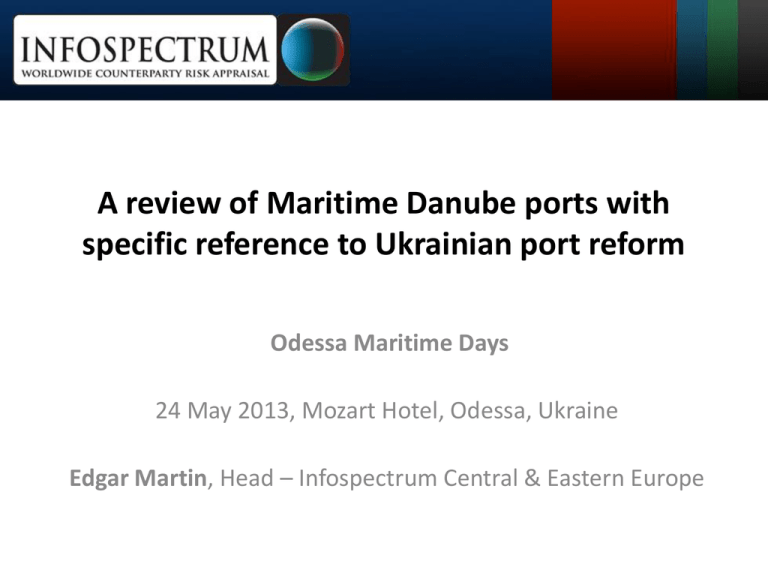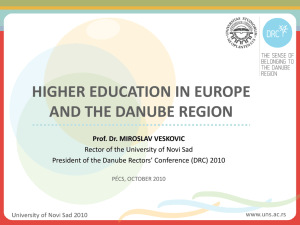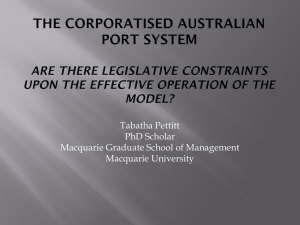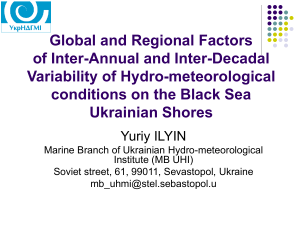Edgar Martin - Maritime days in Odessa
advertisement

A review of Maritime Danube ports with specific reference to Ukrainian port reform Odessa Maritime Days 24 May 2013, Mozart Hotel, Odessa, Ukraine Edgar Martin, Head – Infospectrum Central & Eastern Europe source: VT Explorer source: via donau Brăila – km170 Galați – M81 (Giurgiulești) – NM72.2 Reni - M68.7 (Isaccea) – M56 Tulcea – M38.5 (Mahmudia) – Sf. Gheorghe arm (Sulina) – M0 Izmail – Kilia arm km92 (Kilia) – Kilia arm km47 (Ust-Dunaisk) – Black Sea Maritime Danube port facilities • Dry bulk – dominates fluvial and maritime Danube traffic – Coal, coke, iron ore, finished and semi-finished steel products, grain, paper scrap metal • Container terminals – Designated at virtually every port – Purpose-built facilities in Galați and Giurgiulești – Only Giurgiulești has a current scheduled liner service • Oil Terminals – Reni (UA), Giurgiulești (MD), Galați (RO), and smaller terminals and bunkering facilities • Bunkering – Izmail, Mile 61 (2-3 suppliers), Giurgiulești, Galați, bunker barges 2012 (2011, 2010) Port Traffic (MT) • • • • Izmail (UA) Tulcea (RO) Reni (UA) Giurgiulesti (MD)* • Galati (RO) • Braila (RO) 2.9m (4.9m, 6.6m) 2.2m (2.3m, 2.4m) 1m (1.6m, 1.5m) 277,500 (321,000, 371,000) 3.9m (5.1m, 6.4m) 2.2m (3.1m, 3.0m) Source: port administrations and news reports *=GIFP only, state port sources estimate +100,000MT Maritime Danube ports: together, a significant Black Sea player • Principal Maritime Danube ports in all 3 countries - total traffic handled 2010: 20.3m MT • Port of Odessa - total traffic handled 2010: 24.7m MT Maritime Danube ports: Opportunities • • • • • • Trimodal transport hubs; Both 1435mm and 1520mm rail gauges in two ports; Facilities within the EU or CIS; Port capacities significantly higher than recent volumes (Izmail 8.5m MT); Maritime Danube: 7m draught available, typically up to 12,000-dwt; Fluvial Danube: direct access across Europe via the Danube, Main-Danube Canal and Rhine (Danube carried c.45m MT in 2011, approx half the 1987 figure and possibly only 10% of the existing capacity); • (Ukraine was the largest single exporter on the Danube with approx 6.8m MT in 2010) • Active shipbuilding and shiprepair facilities in UA and RO; • Significant foreign investment in RO and MD, for example Mittal Steel and Damen Shipyards in Galaţi, Danube Logistics Holding BV in Giurgiuleşti. Maritime Danube port ownership and operation • Fully private (MD) • State landlord, private operation (UA, RO) • Fully state (UA, MD) • Municipal ownership tried in Romania in the early 2000s (certain small ports remain under local control); • Then, port administrative and commercial functions were separated, with long-term concessions awarded for the latter; • Ports highly political in all three countries; • Critical politically, economically and strategically; • Social aspect; • In the public eye. Current crisis at Maritime Danube ports: explanations and opinion • Impact of economic crisis only one of the factors in the recent traffic decline; • Fluvial traffic – too focused on individual sectors, commodities and specific clients, for example: – – Železara Smederevo (Serbia) mothballed for much of 2012; voestalpine (Austria) reportedly reduced production – single largest customer of Danube transport. • Maritime traffic – high channel costs: – – Romanian Sulina Channel: very expensive access (only 1,467 transits in 2012); Ukrainian Bystroe Channel: somewhat cheaper, but less available draught. Current crisis at Ukrainian Danube ports: explanations and opinion • Accusations in the press of the recent unofficial dramatic increase in handling tariffs, for example for iron ore pellets at Izmail from US$4/MT to US$7/MT; • Kostyantin Zhevago’s Ferrexpo group acquired major Danube shipping group Helogistics Holding GmbH of Austria in 2010. Ferrexpo, previously one of the largest single customers in Izmail, reduced activities there following tariff rises in 2011. • Reni suffers from high Moldovan railway transit charges; • Strategic “Danube Corridor” Ukrainian national project shelved (which included a new Odessa-Reni road, Izmail-Reni railway and other major infrastructure projects and initiatives). Reni – annual traffic • • • • Design capacity: 14m MT Peak year: 1989, 10.5m MT Previous lowest result: 2000, 1.12m MT 2012 traffic: 1m MT Ukrainian port reform • REFORM IS URGENTLY REQUIRED! • Outdated legal system in place in the Ukrainian port sector; • The new port law is generally regarded as progress - the right direction for Ukraine’s larger ports, aiming to attract private investors. • But what of the loss-making ports, such as those on the Ukrainian Danube, which have suffered a catastrophic decline in traffic handled in recent years? Port reform: local situation • HIGHLY controversial subject in Reni and Izmail – an extremely emotive issue. • Difficult to find a balance of opinion from the Ukrainian Danube region; • Workers, management, agents, local residents, entrepreneurs, state employees – all those we approached were sceptical of the forthcoming reforms. • One February 2013 online article on port reform currently has 827 reader comments; • Disagreements between trade unions; • Little trust shown towards the government and large Ukrainian business; • Main concern: the likely employment impact. Port reform: local opinion personal viewpoints provided to EM / published in May 2013 • • • • • • • Quotation in multiple press reports: “This is the collapse of the [ports] industry, imposed by the oligarchs.” Port worker: “Port reform is beneficial only to the oligarchs and will result in monopolistic control of the ports.” Agent: “Reform is needed but I doubt it will be done in a civilised manner; the reform will lead to a reduction in market players and a monopolisation of a given port.” Port employee: “the port law is sound and consistent with many other countries, where it may work, but this is turned on its head when you consider the reality of life here.” Former UDP employee: “Izmail and Odessa ports cannot be organised by the same rules.” UDP employee: “How will the port law work without the private investor?” Extreme scenario put forward by various sources - private ownership of certain facilities will result in their closure with cranes and other port equipment sold for scrap. Government response • Deputy Minister Dmitry Demidovich, March 2013, discussing Danube ports and port reform – “In terms of investor interest in these ports, I think that if not today, not tomorrow, maybe the day after tomorrow - there will be investors who want to link their lives and their destinies with these enterprises and this region.” • Recognising the specific problems of the Danube ports, the Deputy Minister reduced port and rail tariffs for certain commodities in April 2013 in an attempt to attract more of this core traffic back to Reni and Izmail; • Additional monthly freight flow of 20,000 MT already secured. Port reform: employment impact • Labour reform is key to port reform in most countries; • This is the principal concern of most who are opposed to the reform on the Ukrainian Danube; • Assurances have been made that “not one port worker will be dismissed” through the port reform; • Nevertheless, for other reasons, significant layoffs have been underway since late 2012; • The government estimates that the reformed port sector will result in the creation of up to 10,000 new jobs in the long term. Ukraine’s port reform model – how does it compare? • • • “Port privatisation” - an ambiguous term with a variety of definitions; poorly implemented in the U.K. for example – certain facilities sold to management for arguably well below market value (some then sold on to private port/investment companies at substantial profit to management); in some cases, navigational safety and port supervision also became the responsibility of the private port authority in a blatant conflict of interest. Full port privatisation included the entire port estate with no remaining government control. [reference early 1980s British port privatisation] Optimum solution worldwide - state landlord role with private operators on long-term concessions, as envisaged in the port law (although there are certain locations where this does not work). Sensibly, Ukraine’s main port facilities will remain under state control, with commercial operations and administrative functions to be separated. Arguably, this has been achieved successfully in many locations worldwide, including elsewhere on the Maritime Danube (Romania). Summary • Reform is urgently needed at the Ukrainian Danube ports; • On paper, Ukrainian port reform is generally a well thought-out piece of legislation to improve the competitiveness of the sector and thus benefit the Ukrainian economy. It could bring Ukraine in line with a worldwide port ownership norm. • But how will it be implemented in practice? • What will be the social and political cost? • Will it result in unfair/monopolistic advantages to large Ukrainian industrial groups? • We will soon find out. Trusted by some of the world’s largest companies since 1999. Oil majors, trading houses, international commodity traders, trade and ship finance banks, charterers, ship owners, insurers, P&I clubs and bunker suppliers. Infospectrum Limited 60 St Aldates Oxford OX1 1ST UK Registered in England and Wales No. 3865472 www.infospectrum.net Disclaimer This presentation is not intended to form the basis of a decision to purchase of products and services, or securities, or any other investment decision and does not constitute an offer, invitation or recommendation for the sale or purchase of products and services, or securities, or any investment decision. Neither the information contained in this presentation nor any further information made available in connection with the subject matter contained herein will form the basis of any contract. This presentation does not purport to be comprehensive or to contain all the information that a prospective delegate, business partner, lender or investor may need. The information contained herein is based on currently available information and sources, which we believe to be reliable, but we do not represent it is accurate or complete. The recipients of this presentation must make their own investigation and assessment of the ideas and concepts presented herein. No representation, warranty or undertaking, express or implied, is or will be made or given and no responsibility or liability is or will be accepted by Infospectrum or by any of its affiliates, directors, officers, employees in relation to the accuracy or completeness of this presentation or any other written or verbal information made available in connection with the ideas and concepts presented herein. Any responsibility or liability for any such information is expressly disclaimed. In providing this presentation, Infospectrum undertakes no obligation to provide the recipient with access to any additional information, or to update, or to correct any inaccuracies which may become apparent in, this presentation or any other information made available in connection with the ideas and concepts presented herein. Thank you for your attention! E-mail: edgar@infospectrum.net Mobile: +380 963 605 615 Views expressed in this presentation are not necessarily those of Infospectrum Ltd.












